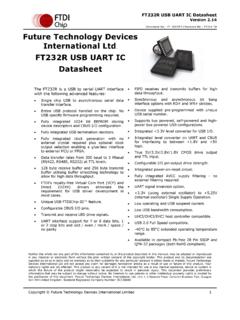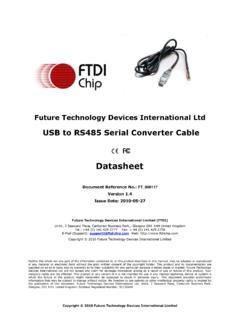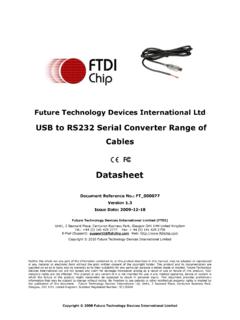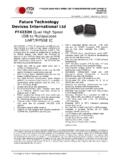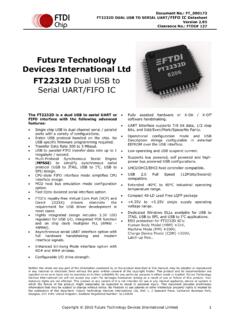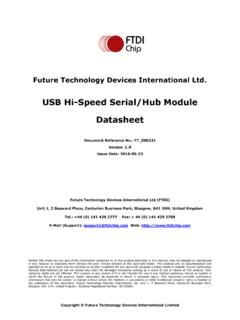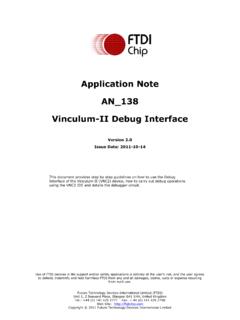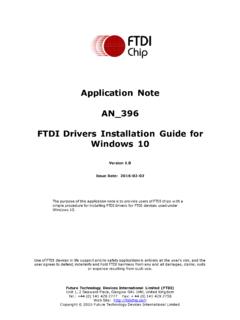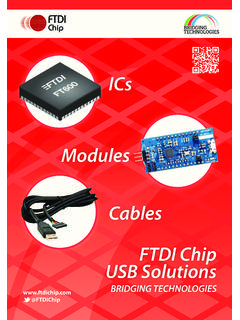Transcription of Simplified Description of USB Device Enumeration - FTDI
1 Future Technology devices International Limited (FTDI) Unit1, 2 Seaward Place, Centurion Business Park, Glasgow G41 1HH United Kingdom Tel.: +44 (0) 141 429 2777 Fax: + 44 (0) 141 429 2758 E-Mail (Support): Web: Copyright 2009 Future Technology devices International Limited Future Technology devices International Ltd. Technical Note TN_113 Simplified Description of USB Device Enumeration Document Reference No.: FT_000180 Version Issue Date: 2009-10-28 USB Enumeration is the process of detecting, identifying and loading drivers for a USB Device . The purpose of this document is to provide an overview of the mechanics of the process. Copyright 2009 Future Technology devices International Limited 1 Document Reference No.: FT_000180 Simplified Description of USB Device Enumeration Technical Note TN_113 Version Clearance No.: FTDI #118 TABLE OF CONTENTS 1 2 2 Detecting a Device has been Connected.
2 3 3 Determining the Device Speed .. 4 4 Determining What Device is Attached ( Device Descriptor) .. 5 bLength.. 5 bcdUSB.. 5 bDeviceClass, bDeviceSubClass and bProtocol .. 5 bMaxPacketSize .. 6 idVendor and idProduct .. 6 iManufacturer, iProduct and iSerialNumber .. 6 5 Determining the Device Configuration (Configuration Descriptor) .. 7 wTotaLength .. 7 bNumInterfaces .. 7 bConfigurationValue .. 7 iConfiguration .. 7 bmAttributes .. 7 7 6 Determining the Device Interface (Interface Descriptor) .. 8 bInterfaceNumber .. 8 bAlternateSetting .. 8 bNumEndpoints .. 8 bInterfaceClass, bInterfaceSubClass and 8 iInterface .. 8 7 Loading the Driver .. 9 8 Summary .. 10 9 Contact 11 Appendix A Terminology .. 13 Appendix B Enumeration Flow .. 14 Appendix C Device Classes .. 15 Appendix D Standard Descriptor Types .. 16 Appendix E References .. 17 Appendix F Revision History.
3 18 Copyright 2009 Future Technology devices International Limited 2 Document Reference No.: FT_000180 Simplified Description of USB Device Enumeration Technical Note TN_113 Version Clearance No.: FTDI #118 1 Introduction USB Enumeration is the process of detecting, identifying and loading drivers for a USB Device . This involves a mixture of hardware techniques for detecting something is present and software to identify what has been connected. The purpose of this document is to provide an overview of the mechanics of the process. Copyright 2009 Future Technology devices International Limited 3 Document Reference No.: FT_000180 Simplified Description of USB Device Enumeration Technical Note TN_113 Version Clearance No.: FTDI #118 2 Detecting a Device has been Connected A USB interface consists of 4 wires. Power, Ground, Data Plus (USBDP) and Data Minus (USBDM). A USB host port with no devices connected uses 15kohm resistors to connect both USB DP and USB DM to GND.
4 When a USB Device (sometimes referred to as a slave) is plugged into a USB host there is a change on these USB data lines. It is this change that the USB host uses to detect a Device has been connected. This change is also used to identify the speed of Device attached. Copyright 2009 Future Technology devices International Limited 4 Document Reference No.: FT_000180 Simplified Description of USB Device Enumeration Technical Note TN_113 Version Clearance No.: FTDI #118 3 Determining the Device Speed A low speed USB Device ( ) uses a 1k5 pull-up resistor to VCC on the USB DM signal line. A full speed USB Device (12 Mbps) uses a 1k5 pull-up resistor to VCC on the USB DP signal line. A high speed USB Device (480 Mbps) will initially appear as a full speed Device to the host. The first thing the USB host does is to attempt to send /receive packets at high speed to the USB Device . This is known as J and K chirp and if communication is successful it will be assumed that the USB Device is a high speed Device .
5 If this initial communication fails then the USB host assumes that the Device is a full speed Device . This means a high speed Device has a 1k5 pull up resistor on USB DP that can be switched in / out of circuit. A J state is defined as a differential signal on USBDP and USB DM >= +300mV. A K state is defined as a differential signal on USBDP and USB DM >= -300mV. Figure 1: Connection of low / full speed devices . Copyright 2009 Future Technology devices International Limited 5 Document Reference No.: FT_000180 Simplified Description of USB Device Enumeration Technical Note TN_113 Version Clearance No.: FTDI #118 4 Determining What Device is Attached ( Device Descriptor) devices are identified by descriptors. Once the USB host has established a USB Device is connected, and at what speed it should communicate, then the host will reset the USB Device and attempt to read the descriptors to identify the USB Device using a default address.
6 This basically follows a question and answer process. The USB host will send a Get_Device_Descriptor command and then receive a packet of bytes with the descriptor length and the actual descriptor. At the completion of this stage the Device is reset and given a unique address before getting the configuration and interface descriptors. bLength = 18 bDescriptorType = 1 bcdUSB bDeviceClass bDeviceSubClass bDeviceProtocol bMaxPacketSize idVendor idProduct bcdDevice iManufacturer iProduct iSerialNumber bNumConfigurations bLength. All USB devices have descriptors and the first key one is the Device Descriptor. The length is 18 bytes and it is bDdescriptorType is type 1. bcdUSB. This is used to identify the Device as a USB , USB or USB compliant Device . bDeviceClass, bDeviceSubClass and bProtocol The bDeviceClass of Device defines the Device type a USB Mouse is a Human Interface Device (HID) class Device .
7 This is given a hex value of 0x03. More complex devices such as Communication Device Class (CDC) may also use a sub class to break down the Device type into a smaller group. bProtocol is used to qualify the sub class. For a full list of defined Device classes see Appendix B. Copyright 2009 Future Technology devices International Limited 6 Document Reference No.: FT_000180 Simplified Description of USB Device Enumeration Technical Note TN_113 Version Clearance No.: FTDI #118 bMaxPacketSize This defines the maximum number of bytes in a packet from an endpoint idVendor and idProduct The idVendor (VID) is assigned to a company by the USB Implementers Forum. An idProduct (PID) is used with this value to help associate a Device with a manufacturer and product. It is also used to help link the hardware with a specific driver. (see AN_107 Advanced Driver Options for more information on driver inf files).
8 IManufacturer, iProduct and iSerialNumber These values are indexes to the Manufacturer string, the Product name string, and the Serial Number strings. These descriptors help make the identifiers more human readable and can be of variable length. Copyright 2009 Future Technology devices International Limited 7 Document Reference No.: FT_000180 Simplified Description of USB Device Enumeration Technical Note TN_113 Version Clearance No.: FTDI #118 5 Determining the Device Configuration (Configuration Descriptor) The Configuration Descriptor is of a fixed length 9 bytes and is defined as type 2. This provides Device specific information such as the number of interfaces supported by the Device and maximum power the Device is expected to consume. bLength = 9 bDescriptorType = 2 wTotallength bNumInterfaces bConfigurationValue iConfiguration bmAttributes bMaxPower wTotaLength This parameter defines the total length of the descriptor.
9 BNumInterfaces This parameter defines the number of interfaces supported bConfigurationValue Value to use as an argument to the SetConfiguration() request to select this configuration iConfiguration This parameter gives the index of the strings to describe the configuration. bmAttributes This parameter defines specific configuration attributes support for remote wake or whether the Device is bus [powered or self powered. bMaxPower This parameter defines the maximum power the Device is expected to consume. Copyright 2009 Future Technology devices International Limited 8 Document Reference No.: FT_000180 Simplified Description of USB Device Enumeration Technical Note TN_113 Version Clearance No.: FTDI #118 6 Determining the Device Interface (Interface Descriptor) The Interface Descriptor is of a fixed length 9 bytes and is defined as type 4. This provides information such as the number of endpoints to be used FTDI devices use one IN and one OUT for each interface.]
10 BLength = 9 bDescriptorType = 4 bInterfaceNumber bAlternateSetting bNumEndpoints bInterfaceClass bInterfaceSubClass bInterfaceProtocol iInterface bInterfaceNumber This parameter defines the number of the interface being described. bAlternateSetting This parameter is used to select this alternate setting for the interface selected by bInterfaceNumber. bNumEndpoints This parameter defines the number of endpoints used by this interface. bInterfaceClass, bInterfaceSubClass and bInterfaceProtocol These parameters define the class of the interface similar to the classes defined in the Device descriptor. iInterface This parameter provides the index for the string descriptor used to describe this interface. Copyright 2009 Future Technology devices International Limited 9 Document Reference No.: FT_000180 Simplified Description of USB Device Enumeration Technical Note TN_113 Version Clearance No.
